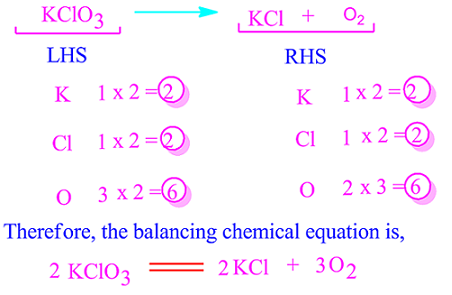Balancing chemical equations definition for class 10 with simple examples
Balancing chemical equations definition for class 10 with simple examples
Balancing chemical equations for any chemical changes are very important matter. Because of this any chemical change is just a chemical reaction.
Chemical changes such as burning of magnesium ribbon in air, rusting of iron etc are chemical reaction.
Substances
that react to these chemical changes are called reagents or reactants. Substances
that are produced as a result of chemical changes are called products.
Now, according to the law of mass action, the mass of the reactants and the products must be equal. Hence, balancing chemical equations is essential for chemical reaction.
A chemical equation is a method of summarizing a chemical reaction by maintaining the balance between the reactants and the products with the help of chemical symbols and formula.
The
chemical equation is expressed by writing the reactants on the left and the
products on the right.
An arrow is drawn from the
reactant to the product.
This implies that the product is produced from the reactant.
If
there are more than one reactants or products, they should be added by plus
sign. The equation of chemical equations has to be balanced.
That
is, the number of atoms of the reactant and the reactant has to be equal.
Because according to the law of mass action, the mass of the reactants and the
products must be equal.
Neither
mass can be created nor destroyed. Thus the chemical equation is multiplied on
both sides by the number required to maintain the equality of the atom number
atoms of the two sides of the substance.
When the number of atoms on the both sides is
equal, the chemical equation is completed by putting equal marks instead of
arrow marks.
Balancing
of chemical equations by trial method
First, the total number of different atoms on the left and right side of the chemical equation must be written separately. Then the number of first atoms on both sides must be compared.
Where the number of first atoms is greater, the number of atoms must be equalized by multiplying by the appropriate number on the opposite side.
The number of the second atom will be unequal when the number of the first atom is equal.
In
the same way the number of atoms like second and third must be equalized by
multiplying by the appropriate number.
In this way, before the reactants on the left and the products on the right, the appropriate number must be placed before the chemical equation to see if the number of different atoms on both sides is equal or not.
When
the number of atoms on both sides is equal, the chemical equation is completed
by putting equal marks instead of arrow marks.
For example, on heating potassium chlorate
produces potassium chloride and oxygen.
2 KClO3 ⟶ 2 KCl + 3 O2 ↑
This reaction has three oxygen atoms on the left and two oxygen atoms on the right.
To
make the number of oxygen atoms on both sides equal, put two before the
potassium chlorate on the left and 3 before the oxygen on the right, so that
the number of oxygen atoms on both sides is equal.
Now the number of K and Cl atoms increases to
2 for placements of 2 before potassium
chlorate.
So if we put 2 before KCl on the right, the chemical equation will be balanced. Therefore the balancing chemical equation is expressed as shown below.
Another
example of balancing chemical equation is show below.
Some chemical equations as examples are given below for balancing.
- Balancing chemical equations definition for class 10 with simple examples
- Balancing chemical equations rules
- Balancing chemical equations by trial method
- Balancing chemical equations solutions simple examples
- Balancing chemical equations practice problems solutions
Balancing
chemical equations, balancing chemical equations for class 10, balancing
chemical equations rules, balancing chemical equations by trial method,
balancing chemical equations solutions simple examples, balancing chemical
equations practice problems solutions, balancing chemical equations for class
9, balancing chemical equations for class 8,
Read more : Oxidation and reduction reactions in chemistry












No comments